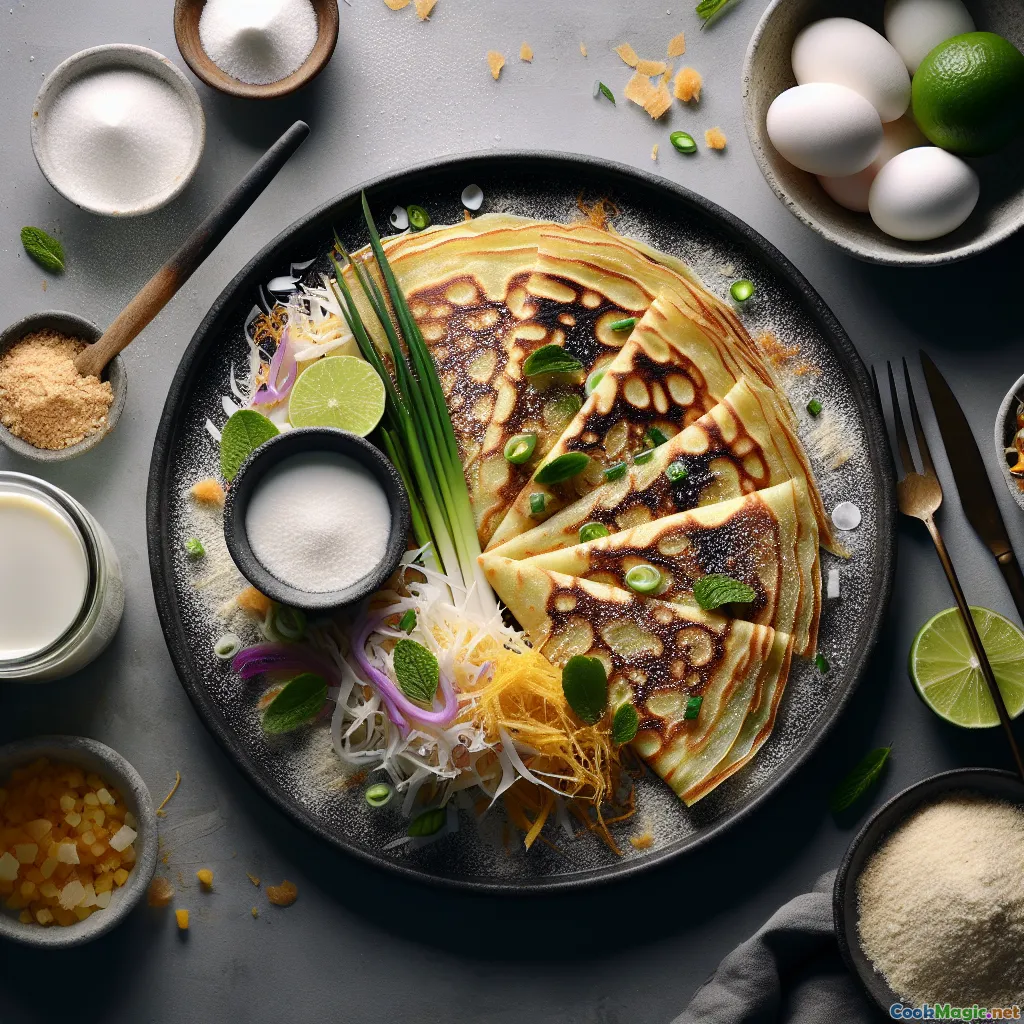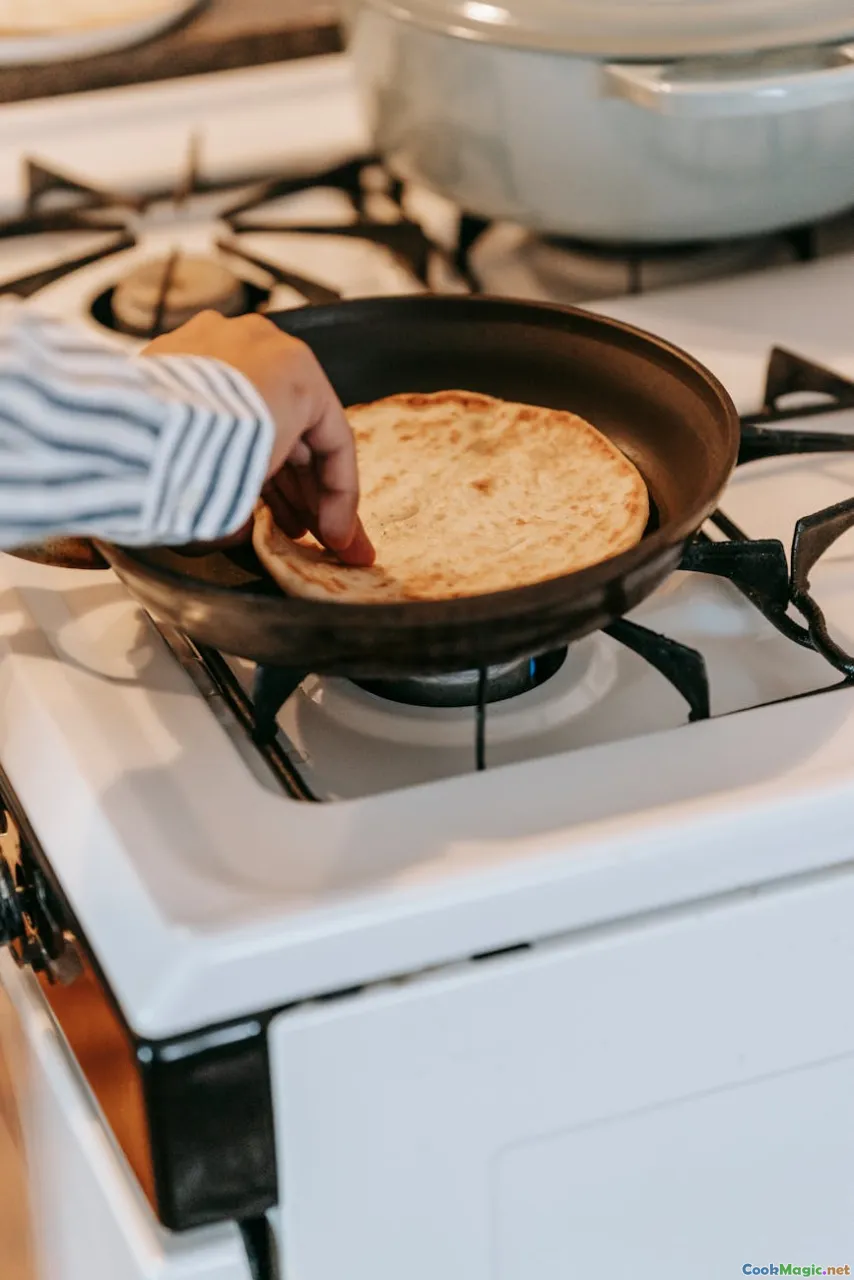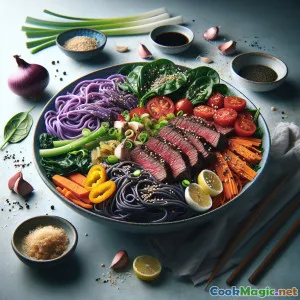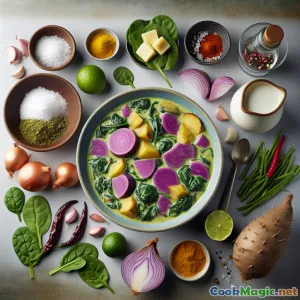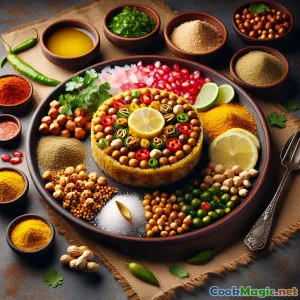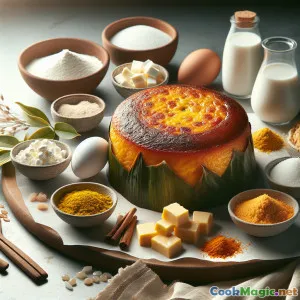
Chrupiący placek z taro i kokosem z patelni
(Crisp Taro-Coconut Skillet Flatbread)
(0 Recenzje)0
139
październik 03, 2025
Zgłoś problem
Składniki
-
400 grams Korzeń taro, obrany i drobno starty
(Use gloves when peeling; cook thoroughly to neutralize oxalates.)
-
200 ml Mleko kokosowe pełnotłuste, dobrze wstrząśnięte
(Niu means coconut; use unsweetened for best control of sweetness.)
-
220 grams Mąka uniwersalna
(For gluten-free: 50% rice flour + 50% tapioca or cassava flour.)
-
1.5 tsp Proszek do pieczenia
(Provides lift; reduce slightly in very humid climates.)
-
1 tsp drobna sól morska
(Dostosuj do smaku.)
-
1 tsp Cukier granulowany
(Balances taro’s earthiness; omit for fully savory bread.)
-
2 tbsp Wiórki kokosowe
(Adds texture and aroma.)
-
2 tbsp Zielona cebulka, cienko pokrojona
(Savory variation; mix into dough or sprinkle after cooking.)
-
1.5 tbsp Olej kokosowy, roztopiony
(Tenderizes the dough and aids browning.)
-
30-60 ml Woda, w razie potrzeby
(Add just enough to form a soft, pliable dough.)
-
2 tbsp Olej kokosowy lub ghee, do gotowania
(Choose coconut oil to keep the recipe dairy-free.)
-
2 tbsp Mąka ryżowa do oprószania
(Prevents sticking and promotes crisp edges.)
-
1 whole Kawałki limonki
(Serve for brightness.)
-
0.5 tsp Płatki soli morskiej, do wykończenia
(Sprinkle over hot flatbreads.)
(Use gloves when peeling; cook thoroughly to neutralize oxalates.)
(Niu means coconut; use unsweetened for best control of sweetness.)
(For gluten-free: 50% rice flour + 50% tapioca or cassava flour.)
(Provides lift; reduce slightly in very humid climates.)
(Dostosuj do smaku.)
(Balances taro’s earthiness; omit for fully savory bread.)
(Adds texture and aroma.)
(Savory variation; mix into dough or sprinkle after cooking.)
(Tenderizes the dough and aids browning.)
(Add just enough to form a soft, pliable dough.)
(Choose coconut oil to keep the recipe dairy-free.)
(Prevents sticking and promotes crisp edges.)
(Serve for brightness.)
(Sprinkle over hot flatbreads.)
Wartości odżywcze
- Porcje: 6
- Wielkość porcji: 1 flatbread (90g)
- Calories: 380 kcal
- Carbohydrates: 0 g
- Protein: 6 g
- Fat: 17 g
- Fiber: 5 g
- Sugar: 4 g
- Sodium: 420 mg
- Cholesterol: 0 mg
- Calcium: 60 mg
- Iron: 1.8 mg
Instrukcje
-
1 - Prep the taro safely:
Wearing gloves, peel the taro and finely grate it. Taro contains oxalates that can irritate skin; cooking neutralizes them. Squeeze gently to remove excess liquid without drying it out.
-
2 - Combine Dry Ingredients:
In a large bowl, whisk flour, baking powder, fine salt, and sugar (if using). Stir in desiccated coconut and spring onion, if desired.
-
3 - Build the dough:
Add grated taro to the dry mix. Pour in coconut milk and melted coconut oil. Stir with a spoon until shaggy. Drizzle in water, a little at a time, until a soft, slightly tacky dough forms.
-
4 - Rest and hydrate:
Cover the bowl and rest 10 minutes to allow flour and taro starches to hydrate. This makes shaping easier and improves tenderness.
-
5 - Divide and shape:
Dust the counter with rice flour. Turn out the dough and divide into 6 equal pieces. Roll or pat each into a 12–14 cm disc, 4–5 mm thick, dusting as needed to prevent sticking.
-
6 - Preheat skillet:
Heat a cast-iron or heavy nonstick skillet over medium. Lightly brush with coconut oil or ghee.
-
7 - Cook until golden:
Lay a disc in the hot skillet. Cook 2–3 minutes until the surface bubbles and the underside is golden. Flip and cook another 2–3 minutes, pressing lightly with a spatula to encourage puffing. Adjust heat to avoid scorching. Repeat with remaining discs.
-
8 - Finish and Season:
Brush hot flatbreads with a touch of coconut oil. Sprinkle sea salt flakes and additional spring onion if desired.
-
9 - Serve island-style:
Serve warm with lime wedges. Excellent with coconut cream (lolo), chili relish, or as a wrap for grilled fish, eggs, or vegetables.
Wearing gloves, peel the taro and finely grate it. Taro contains oxalates that can irritate skin; cooking neutralizes them. Squeeze gently to remove excess liquid without drying it out.
In a large bowl, whisk flour, baking powder, fine salt, and sugar (if using). Stir in desiccated coconut and spring onion, if desired.
Add grated taro to the dry mix. Pour in coconut milk and melted coconut oil. Stir with a spoon until shaggy. Drizzle in water, a little at a time, until a soft, slightly tacky dough forms.
Cover the bowl and rest 10 minutes to allow flour and taro starches to hydrate. This makes shaping easier and improves tenderness.
Dust the counter with rice flour. Turn out the dough and divide into 6 equal pieces. Roll or pat each into a 12–14 cm disc, 4–5 mm thick, dusting as needed to prevent sticking.
Heat a cast-iron or heavy nonstick skillet over medium. Lightly brush with coconut oil or ghee.
Lay a disc in the hot skillet. Cook 2–3 minutes until the surface bubbles and the underside is golden. Flip and cook another 2–3 minutes, pressing lightly with a spatula to encourage puffing. Adjust heat to avoid scorching. Repeat with remaining discs.
Brush hot flatbreads with a touch of coconut oil. Sprinkle sea salt flakes and additional spring onion if desired.
Serve warm with lime wedges. Excellent with coconut cream (lolo), chili relish, or as a wrap for grilled fish, eggs, or vegetables.
Więcej o: Chrupiący placek z taro i kokosem z patelni
Why Niu Milk and Taro Flatbread
This recipe celebrates two of the Pacific’s most beloved staples: taro and coconut (niu). Drawing inspiration from Samoan kitchens—where taro features alongside coconut-rich dishes like palusami—these skillet flatbreads are a contemporary, home-cook-friendly twist on island flavors. The result is a tender yet crisp flatbread that’s subtly sweet, gently nutty, and beautifully aromatic.
Flavor and Texture
Taro brings earthy depth and a satisfying chew, while coconut milk infuses roundness and moisture. Melted coconut oil helps the edges crisp in a hot skillet, so you get that irresistible contrast: delicate crunch outside, pillowy softness within. A whisper of sugar accentuates the coconut’s natural sweetness, but this bread stays firmly versatile—equally at home under savory toppings or with a drizzle of honey.
Technique Tips
- Handle taro with care: Raw taro contains calcium oxalate crystals. Wear gloves while peeling and grate it finely; proper cooking in the skillet neutralizes irritation risk. If your taro is especially wet, lightly squeeze out excess moisture before mixing.
- Hydration matters: Taro starch and flour absorb liquid at different rates, so add water gradually. Aim for a soft, slightly tacky dough—too dry and the bread will crack; too wet and it sticks.
- Rest the dough: A brief rest lets starches hydrate and relax, making it easier to roll and improving tenderness.
- Heat management: Use a heavy skillet. Medium heat is your friend—hot enough to brown and puff, not so hot that the sugars in coconut milk scorch. If you see smoke, reduce the heat and wipe the pan.
Variations and Add-Ins
- Savory scallion: Fold in sliced spring onion for oniony snap. Finish with sea salt flakes and a squeeze of lime.
- Fully dairy-free: Choose coconut oil over ghee for cooking; the bread remains lush without any dairy.
- Gluten-free swap: Use a 1:1 blend of rice flour and tapioca or cassava flour; this keeps the chew and pliability.
- Sweet breakfast: Skip the scallions. Finish with honey, sliced banana, and toasted coconut. A sprinkle of cinnamon complements the taro’s gentle sweetness.
- Spiced island notes: Add pinches of ground coriander, white pepper, or chili flakes to the dough.
Serving Ideas
- With lolo (lightly warmed coconut cream) and chili relish.
- Wrapped around grilled fish, seared tofu, or scrambled eggs.
- As a base for avocado, lime, and herbs—think island toast.
- Alongside soups and stews; the bread soaks up broths without falling apart.
Cultural Note
In Samoa and across Polynesia, taro is more than a crop—it’s a cultural anchor. Traditionally steamed, roasted in the umu (earth oven), or simmered in coconut milk, taro symbolizes sustenance and continuity. This flatbread leans into that heritage while offering an approachable, modern format for everyday kitchens. The name “Niu” nods directly to coconut—the tree of life—whose milk, oil, and flesh nurture flavor and texture throughout the dish.
Make-Ahead and Storage
- Refrigerate: Stack cooled flatbreads with parchment between, store up to 3 days.
- Freeze: Wrap tightly and freeze up to 1 month. Reheat from frozen in a dry skillet, then brush with a touch of coconut oil.
- Dough prep: The shaped discs can rest, covered, in the fridge for several hours; cook straight from cold over a slightly lower flame to prevent scorching.
Troubleshooting
- Dry or cracking dough: Increase hydration with 1–2 teaspoons of water at a time.
- Gummy center: Lower the heat and cook a bit longer. Taro needs sufficient time to cook through.
- Scorching: Your pan is too hot or has residual oil. Wipe and re-oil lightly.
Why You’ll Love It
This flatbread is simple yet special: pantry-friendly, weeknight-fast, and flexible enough to bridge breakfast to dinner. It captures the comfort of homey bread, the nourishment of roots and coconut, and the spirit of island cooking—laid-back, generous, and endlessly adaptable. Whether you’re revisiting childhood flavors or discovering Polynesian ingredients for the first time, Niu Milk and Taro Flatbread is a delicious, practical way to bring the Pacific to your table.
